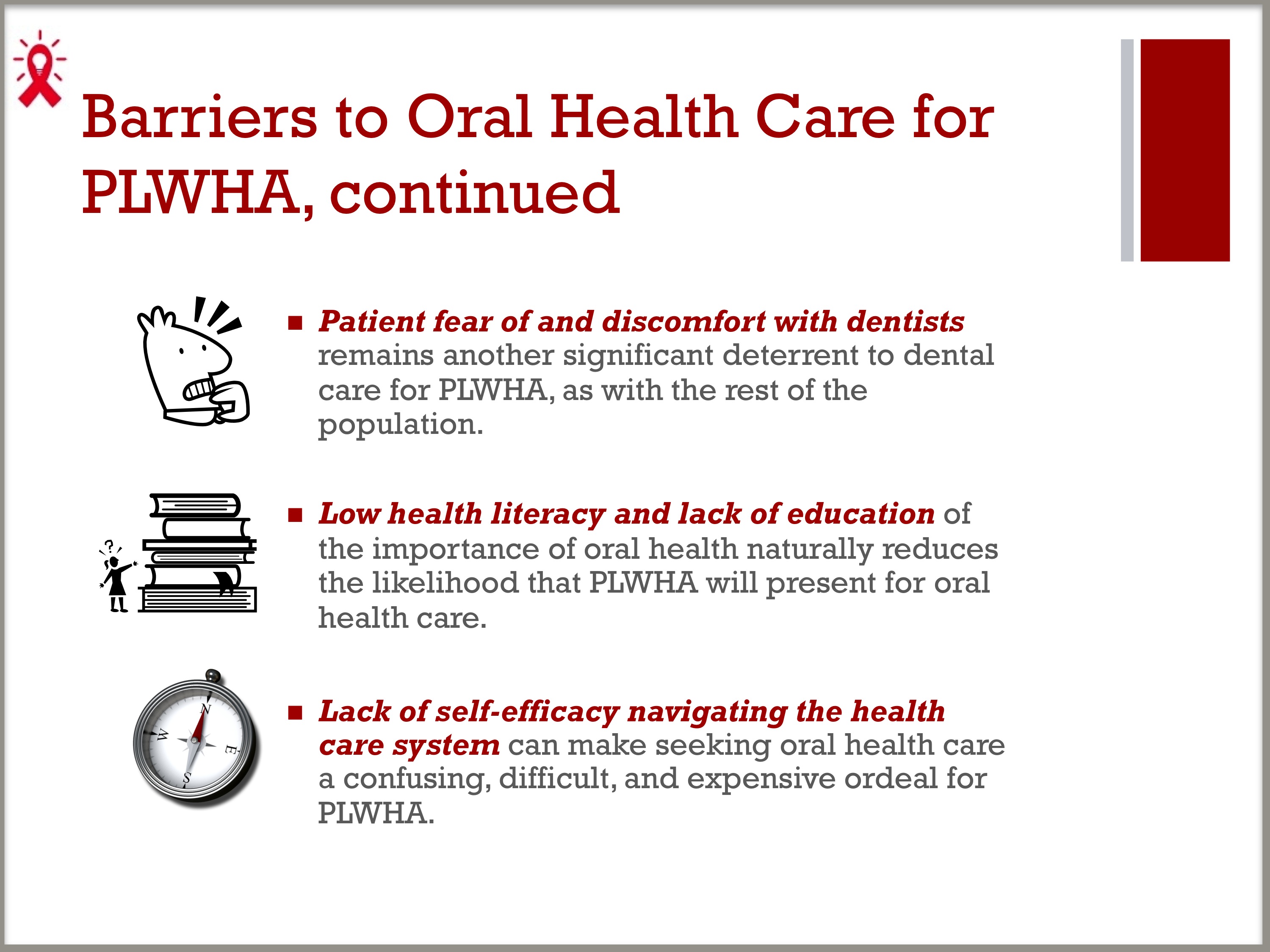 Session Length: 35–45 minutes
Session Length: 35–45 minutes
Summary
The primary objective of this module is to increase understanding of common barriers to oral health care encountered by PLWHA, as well as to improve understanding of the important intersection of oral health and HIV disease.
Materials Needed
- A computer and compatible LCD projector to play the PowerPoint presentation
- Markers or pens
- Paper and easel(s), whiteboard, or other means of taking notes.
POWERPOINT PRESENTATION
SLIDE 1: Oral Health Care is a Major Unmet Need in PLWHA

- PLWHA are more likely to have an unmet need for oral health care than for medical care. Fifty-eight to 64 percent of PLWHA do not receive regular dental care, according to various studies.1
- Between 32 and 46 percent of PLWHA will have at least one major HIV-related oral health problem (e.g., bacterial, viral, and fungal infections as well as cancer and ulcers) in the course of their disease.2
SLIDES 2–4: Barriers to Oral Health Care for PLWHA



- Many of the same barriers to oral health care for PLWHA are the same barriers that prevent them from engaging and staying in HIV medical care.
– Financial concerns are the primary barrier to care: absence of dental insurance, insufficient insurance coverage, inability to pay out-of-pocket for care, etc.3,4
– Dental insurance is not as common in the private sector as medical insurance. The number of adults without dental coverage is three times as high as the number of adults without health insurance coverage.5
– Lack of transportation for patients to attend appointments is a closely related concern, and can be particularly challenging in areas with a scarcity of oral health professionals.
– Stigma can occur when trying to find a culturally competent dentist who understands the needs of PLWHA and their concerns about confidentiality.
– Lack of oral health professionals trained and willing to treat PLWHA is a problematic, systemic barrier to care.
– Patient fear of and discomfort with dentists remains another significant deterrent to dental care for PLWHA, as with the rest of the population.
– Low health literacy and lack of education on the importance of oral health naturally reduces the likelihood that PLWHA will present for oral health care.
– Lack of self-efficacy navigating the health care system can make seeking oral health care a confusing, difficult, and expensive ordeal for PLWHA.
GROUP DISCUSSION
- Below are some questions the Trainer can ask to encourage discussion:
– Do the statistics given about the prevalence of oral health disease in PLWHA surprise you?
– Did you find any of the barriers to care surprising?
– What barriers do you think are missing? Why?
– Would anyone like to share their experiences in helping PLWHA overcome some of these barriers to care? What did you do? What worked and what didn’t work?
GROUP ACTIVITY
- Trainer should lead participants in a role-playing exercise to address common barriers and stigmas.
- Split the group into pairs of 2, with one group member playing the role of the provider, and the other group member playing the role of the patient. Assign each group one of the following scenarios to act out:
– Patient suffering from fear of the dentist; provider attempting to alleviate fears
– Patient with low oral health literacy; provider attempting to educate patient about the benefits of oral health care for overall health and management of HIV disease
– Patient concerned about being stigmatized by dental provider; health care provider seeking to encourage patient that there are dental providers who understand and are sensitive to needs of PLWHA and to follow up on dental referral.
-
After 5 minutes, have the groups report back to the class about revelations from the exercise.
-
Below are some questions the Trainer can ask to encourage discussion:
– Which of these scenarios do you think would be hardest to address with a patient? Why?
– What resources did you feel you would need in order to effectively address some of these scenarios?’
– Are these resources readily available? If not, what would you or the clinic need to do to access them?
1. Marcus M, Maida CA, Coulter ID, et al. A longitudinal analysis of unmet need for oral treatment in a national sample of medical HIV patients. Am J Public Health. Jan 2005;95(1):73–75.
2. Health Resources Services Administration, HIV/AIDS Bureau. Oral Health and HIV. Ryan White HIV/AIDS Program Fact Sheet. Available at: www.hrsa.gov/publichealth/clinical/oralhealth/hivfactsheet.pdf.
3. Marcus M, Maida CA, Coulter ID, et al. A longitudinal analysis of unmet need for oral treatment in a national sample of medical HIV patients. Am J Public Health. Jan 2005;95(1):73–75.
4. Heslin KC, Cunningham WE, Marcus M, et al. A comparison of unmet needs for dental and medical care among persons with HIV infection receiving care in the United States. J Public Health Dent. Winter 2011;61(1):14–21.
5. Henry J. Kaiser Family Foundation. Oral health in the U.S. June 19, 2012.